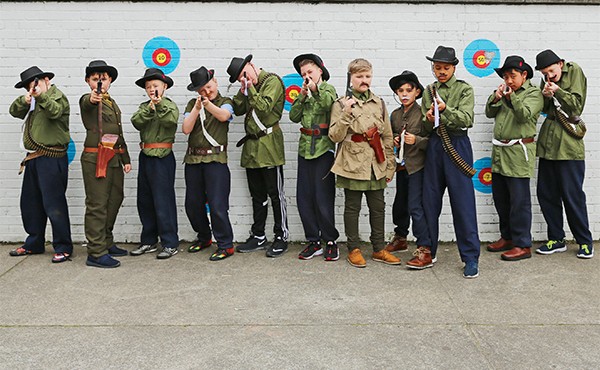
Sixth class pupils of St. Patrick’s Boys School.
A short film covering a school production of the 1916 rising, with the Sixth Class pupils of St Patrick’s Boys School in Ringsend, has recently been produced in the area.
Key features of this short film were the reading of the proclamation of the Republic by Padraig Pearse and the shooting of Michael Joseph O’Rahilly on Moore Street by a British gunner (O’Rahilly House in Ringsend was named in honour of him).
Pat Larkin a local of Ringsend, founder of the St Pat’s Film Club has previously worked on short films with the school. Last year Pat submitted a feature set to the Jeanie Johnston famine-ship museum about the Ouzel Galley that set sail from Ringsend. This film received good commendations from the Films In School (FIS) competition.
Larkin bought little uniforms of British and Irish soldiers on the internet, received donations from charity shops, used empty coal bags from building sites and meticulously designed a cardboard Vickers Machine gun of the British army. Richie Saunders from the local rowing club, carved the wooden rifles for the Irish Volunteers.
The film has been shot on a Canon 5 camera, with 1,214 mins of shooting with various scenes depicting a series of important events in the chronology of the rising.
Ten boys participated, mostly local boys from Pembroke Cottages and Whelan House in Ringsend. Mr Booth, principal of St Patrick’s Boys School, drilled the boys in the sports hall, teaching them to march “left” and “right” in Irish, in line and in synch with each other.
There was a photo shoot before filming with school boy Josh King playing Padraig Pearse giving the orders in Irish, “chlé,” “ceart,” “left,” “right,” drilling the men and inspiring them to action. The children posed in their green Irish Volunteers uniforms before the camera, with their wooden guns strapped to their side, plastic bullets around their waist and donning the felt hats modelled on the Irish Citizens Army.
The first shot comprised of two school boys dressed as British soldiers firing a Vickers machine gun mounted on sand bags. The second shot consisted of the boy’s marching before a green curtain (used particularly for the effects of the camera) with Pearse reading an excerpt from the proclamation of the Irish republic. Mr Lange the class teacher, supervised and instructed the filming and the marching of the school boys.
The next scene was shot around the side of Pembroke Cottages depicting final moments of Joseph O’Rahilly’s life during heavy fire on Moore Street. O’Rahilly played by a moustached Sean Ebbs calls the men to come forward against a British position. O’Rahilly and several of the men were struck down with a British machine gun.
The mortally wounded O’Rahilly takes out a pen and a piece of paper and writes a short note to his wife. Testimonies have reported that O’Rahilly lay in the gutter of Moore Lane for over 19 hours, slowly dying and succumbing to his wounds, guarded by British soldiers after the fighting had ended, a sentry watched him and left him to his fate and that even the ambulance drivers were not permitted to tend his wounds.
Over several weeks, the film has been retouched and several scenes have been edited and reshot for visual perfection and historical authenticity. NewsFour spoke with Pat Larkin, director and producer of this feature about filming the seizure of the GPO.
“We got permission from the GPO to invade it and take it over. There were spectators, members of the public who watched the boys in action, taking up firing positions and it was brilliant the way the Irish Army were raising the flag at the same time. The boys of course loved the attention. I was told that the grandson of O’Rahilly was giving a tour in the basement of the GPO while we were filming there up above.”
Larkin then elaborated on the innovative methods and ideas employed for the film. “The film starts with a history lesson and one of the boys transforms into O’Rahilly and the film is transported into black and white. I wanted to give the film a Pathé film appeal.”
The final shot of the film showed the boys riding in a model T Ford, as a re-enactment of O’Rahilly’s journey to the GPO. O’Rahilly who was initially reluctant to take part in the rising, had a change of heart and infamously said “Well, I’ve helped to wind up the clock – I might as well hear it strike!”
The rest of course is history!
With the current momentum, the national sentiment and historical poignancy from this event, Pat hopes that this year’s’ entry into the Films in School (FIS) competition will do even better than last year’s feature on the Jeanie Johnston tall ship.
By Robert Fullarton



